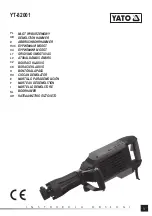
IMPORTANT SAFETY PRECAUTIONS
Hazardous conditions may result if the charger is not installed or operated correctly.
Please read the following instructions to prevent personal injury or damage to the
charger.
BATTERY RELATED
•
To reduce the risk of battery explosion, follow these instructions and those marked
on the battery.
•
Never smoke or allow an open spark or flame in the vicinity of the battery or the
engine.
•
Charge only Lead Acid type of batteries (Flooded / Absorbed Glass Mat (AGM)
/ Gel Cell). Do not charge other type of batteries like Nickel Cadmium (NiCad),
Nickel-Metal Hydride (Ni-MH), Dry-Cell etc. Other types of batteries might
burst causing personal injury.
•
Never charge a frozen battery.
•
Working in the vicinity of Lead Acid batteries is dangerous. Batteries generate
explosive gases during normal operation. Take necessary safety precautions when
installing the charger near a battery or in a battery compartment (Follow safety
instructions given by the battery manufacturer).
•
Never place the charger directly above or below the battery being charged; gases or
fluids from the battery will corrode and damage the charger. Locate the charger as
far away from the battery as DC cables permit. Do not install in the same com-
partment as batteries.
CHARGER RELATED
•
Do not operate the charger in a closed-in area or restrict ventilation in any way.
Install in a well ventilated, cool, dry place.
•
The charger must not be operated in a damp or wet environment. When mounting
in a boat, make sure it is not subjected to bilge water splash.
•
Do not block the ventilation openings / openings for the cooling fan. There should
be at least 6 inches clearance all around the unit.
•
Installation and wiring must comply with the local and the national electrical
codes. It is recommended that installation and wiring may be done by a certified
electrician.
•
Wrong installation on a boat may lead to corrosion of the boat. It is recommended
that installation on the boat must be carried out by a boat electrician.
•
Disconnect the AC input power to the charger before connecting / disconnecting
the batteries or other DC loads or when working on the charger.
•
Disconnect the AC input power before changing the setting of the Dip Switches.
•
The chassis of the charger is connected to the earth ground pin of the power cord
plug. Ensure that the earth ground pin of AC receptacle feeding the charger is
connected to earth ground.
•
Do not use an adapter. If a grounding type of receptacle is not available, do not use
this charger until the proper outlet is installed by a qualified electrician.
•
Do not operate the charger if the power cord is damaged.
Page 2




































